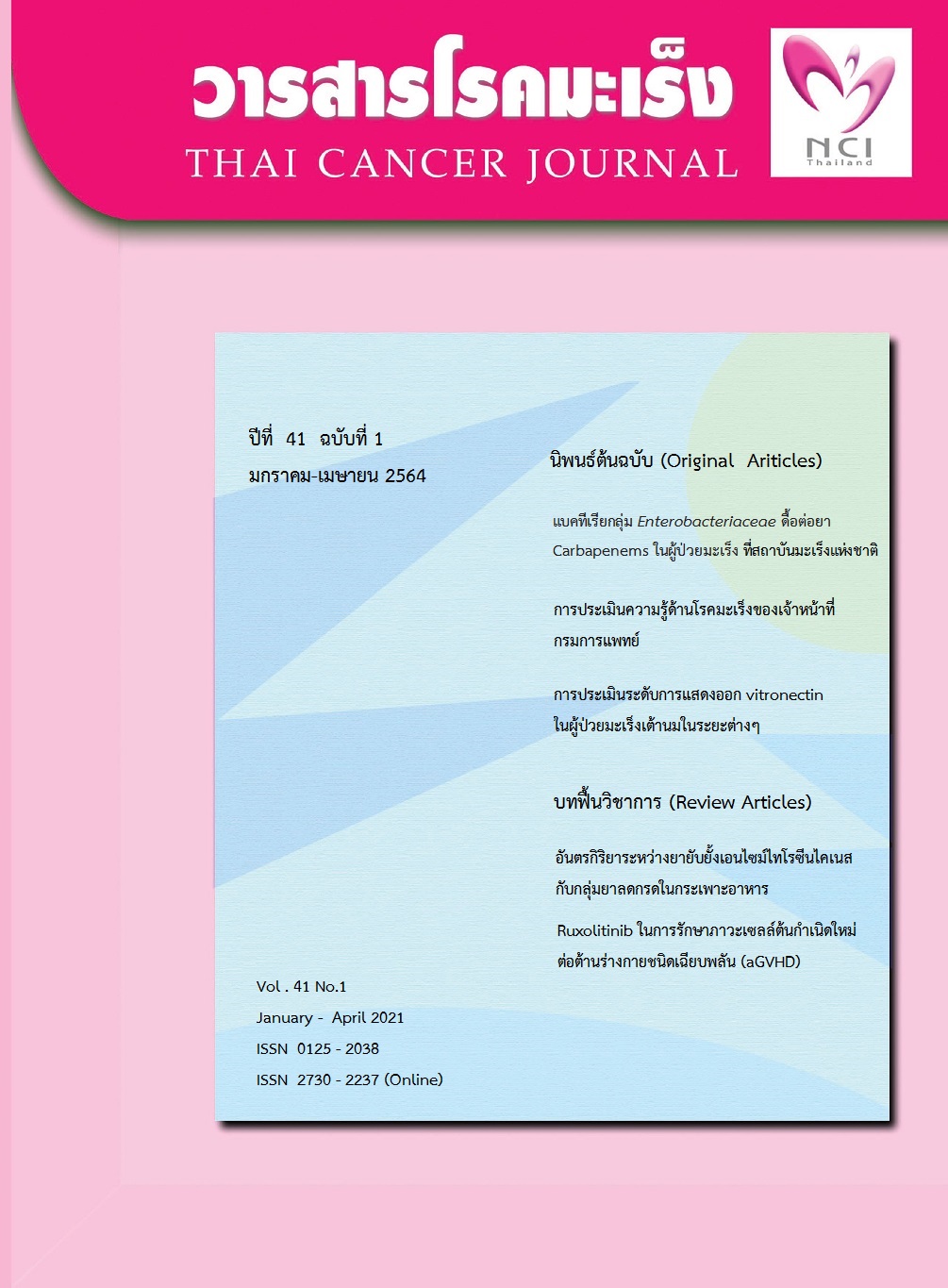Evaluation of vitronectin expression levels from breast cancer patients with different stages
Keywords:
มะเร็งเต้านม vitronectin CEA CA15-3Abstract
Breast cancer is the most common cancer in women worldwide. Currently, there is no specific biomarker for early diagnosis. The identification of potential biomarkers for early detection will ensure a good prognosis and improve the clinical outcome. Vitronectin (VN) is a glycoprotein involved in multifunctional roles in inflammation, cell adhesion, and migration. There are some evidences showed that VN levels were elevated in some cancers, including breast cancer. This study aimed to investigate a new biomarker's efficiency as VN in the early stage of breast cancer. Serum and plasma of VN were collected from 112 breast cancer patients with different stages and 13 healthy women by enzyme-linked immunosorbent assay (ELISA). The clinical biomarkers of breast cancer as CEA and CA15-3 were used as references. The results showed that serum and plasma VN levels were elevated in breast cancer patients with stage II higher than VN levels in other stages. Whereas serum CEA and CA15-3 levels exhibited higher expression levels in serum from breast cancer patients with advanced-stage (II-IV) than early-stage (0-II). However, both clinical biomarkers, CEA, CA15-3 and VN expression levels from the serum of healthy women, showed low expression levels.The area under the curve (AUC) of ROC was also used to determine the efficiency of VN, found that AUC to be about 0.629 with a P<0.05 in breast cancer with early stage. In conclusion, serum and plasma VN may be promising diagnostic biomarkers that can be detected in the serum and plasma of breast cancer patients with early stage. While serum CEA and CA15-3 were useful markers for predicting aggressive cancer in the advanced stage.
References
GLOBOCAN 2020. Estimated cancer incidence,mortality and prevalence worldwide in 2020. Available at http://globocan.iarc.fr/factsheet.asp. Accessed on January 19, 2021.
Imsamran W, Pattatang A, Supaattagorn P, Chaiwiriyabunya I, Namthaisong K, Wongsena M et al editors. Cancer in Thailand Vol IX, 2013-2015, Bangkok 2018.
Wikipedia. Breast cancer. Available at http:// en.wikipedia.org/wiki/Breast_cancer. Accessed on January 19, 2021.
Duffy MJ, Evoy D, McDermott EW. CA15-3: uses and limitation as a biomarker for breast cancer. Clinia Chimica Acta 2010;411:1869-74.
Lumachi F, Basso SMM. Serum tumor markers in patients with breast cancer. Expert Rev Anticancer Ther 2004;4:921-31.
Mirabelli P, Incoronato M. Usefulness of traditional serum biomarkers for management of breast cancer patients. Biomed Res Int 2013;2013:685641.
Maric P, Ozretic P, Levanat S, Oreskovic S, Antunac K, Beketic-Oreskovic L. Tumor Markers in Breast Cancer-Evaluation of their Clinical Usefulness. CollAntropol 2011;35: 241-7.
Hao W, Zhang X, Xiu B, Yang X, Hu S, Liu Z, et al. Vitronectin: a promising breast cancer serum biomarker for early diagnosis of breast cancer in patients. Tumor Biol 2016;37: 8909-16.
Aaboe M, Offersen BV, Christensen A, Angreasen PA. Vitronectin in human breast carcinoma. Biochim Biophys Acta 2003;1638: 72-83.
Burgos-Panadero R, Noguera I, Canete A, Navarro S, Noguera R. Vitronectin as a molecular player of the tumor microenvironment in neuroblastoma. BMC 2019;19:479.
Seiffert D. Constitutive and regulated expression of vitronectin. Histol Histopathol 1997;12: 787-97.
Chow S, Girolamo ND. Vitronectin: A Migration and Wound Healing Factors for Human Corneal Epithelial Cells. Invest Ophthalmol Vis Sci 2014;55:6590-600.
Salazer-Pelazar LM, Abraham T, Herrera AM, Correa MA, Ortega JE, Pare PD, et al. Vitronectin Expression in the Airways of Subjects with Asthma and Chronic Obstructive Pulmonary Disease. PLoS ONE 2015;10:e0119717.
Schneider G, Bryndza E, Poniewierska-Baran A, Serwin K, Suszynska M, Sellers ZP, et al. Evidence that vitronectin is a potent migration-enhancing factor for cancer cells chaperoned by fibrinogen: a novel view of the metastasis of cancer cells to low fibrinogen lymphatics and body cavities. Oncotarget 2016;7:69829-43.
Ortega-Martinez I, gardeazabal J, Erramuzpe A, Sanchez-Diez A, Cortes J, Garcia-Vazquez MD, et al. Vitronectin and dermcidin serum levels predict the metastatic pregression of AJCC I-II early-stage melanoma. Int J Cancer 2016;139:1598-607.
Kadowaki M, Sangai T, Nagashima T, Sakakibara M, Yoshitomi H, Takano S, et al Identification of vitronectin as a novel serum marker for early breast cancer detection using a new proteomic approach. J Cancer Res Clin Oncol 2011;137:1105-15.
Zhu W, Li W, Yang G, Fu C, Jiang G, Hu Q, et al. Vitronectin silencing inhibits hepatocellular carcinoma in vitro and in vivo. Future Oncol 2015;11:251-8.
Kashyap AS, Hollier BG, Manton KJ, Satyamoorthy K, Leavesley DI, Upton Z. Insulin-like growth factor-I: vitronectin complex-induced changes in gene expression effect breast cell survival and migration. Endocrinology 2011;152:1388-401.
Li R, Luo M, Ren M, Chen N, Xia J, Deng X, et al. Vitronectin regulation of vascular endothelial growth factor-mediated angiogenesis. J Vasc Res 2014;51:110-7.
Pola C, Formenti SC, Schneider RJ. Vitronectin-alpha v beta3 integrin engagement directs hypoxia-resistant mTOR activity and sustained protein synthesis linked to invasion by breast cancer cells. Cancer Res 2013;73:4571-8.
Gladson CL, Cheresh DA. Glioblastoma expression of vitronectin and the alpha v beta 3 integrin. Adhesion mechanism of transformed glial cells. J Clin invest 1991;88:1924-32.
Swets JA. Measuring the accuracy of diagnosticsystems. Science 1988;240:1285-93.
Samy N, Ragab HM, Abd El Maksoud N, Shaalan M. Prognosis significance of serum Her2/neu, BCL2, CA15-3 and CEA in breast cancer patients: A short follow-up. Cancer Biomarkers 2010;6:63-72.
Bera A, Subramanian M, Karaian J, Eklund M, Radhakrishnan S, Gana N, et al. Functional role of vitronectin in breast cancer. PLoS ONE 2020;15:e0242141
Kim BK, Lee JW, Park PJ, Shin YS, Lee WY, Lee KA, et al. The multiplex bead array approach to identifying serum biomarkers associated with breast cancer. Breast Cancer Res 2009;11: R22.
Kubota K, Katayama S, Matsuda M, Hayashi M. Three types of vitronectin in human blood. Cell Struct Funct 1988;13:123-8.
LI X, DAI D ,CHEN B, TANG H, XIE X, WEI W. Determination of the prognostic value of preoperative CA15 3 and CEA in predicting the prognosis of young patients with breast cancer. Oncol Lett 2018;16:4679-88.
Downloads
Published
Issue
Section
License
บทความทีตีพิมพ์ในวารสารโรคมะเร็งนี้ถือว่าเป็นลิขสิทธิ์ของมูลนิธิสถาบันมะเร็งแห่งชาติ และผลงานวิชาการหรือวิจัยของคณะผู้เขียน ไม่ใช่ความคิดเห็นของบรรณาธิการหรือผู้จัดทํา







